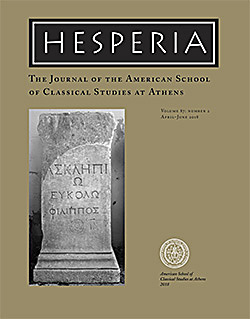Hesperia 87.2 Now Online!

The American School of Classical Studies at Athens is pleased to announce the publication of Hesperia 87.2. Topics in this issue include a reexamination of a Middle Bronze Age cist tomb found in the Athenian Agora; a look at the European influence on the style and execution of bronze shields and spears from Delphi; a study of Boiotian pottery decorated in the colorful style known as the Six’s technique; and an examination of altars at the Asklepieion at Epidauros that were inscribed with symbols and numerals in the Late Antique period.
Subscribers can read the issue online at JSTOR, which now hosts all current issues of Hesperia as well as an archive of past volumes. The printed version will be mailed shortly.
A Cist Tomb on the South Bank of the Eridanos in the Athenian Agora and the Middle Bronze Age in Athens, by Anthi Balitsari and John Papadopoulos, reexamines an early tomb found beneath the south annex of the Stoa Basileios in the Athenian Agora. Originally interpreted as Submycenaean at the time of excavation, the stratigraphy and contents of the grave, as well as a deposit of pottery found nearby, suggest that the grave, in fact, is Middle Helladic in date. The presence of Gray Minyan ware and Cycladic imports in the pottery deposit provide further evidence for the role of Athens in the Middle Helladic period.
European Bronze Age Symbols in Prehistoric Greece? Reconsidering Bronze Shields and Spears from Delphi in Their Wider Context, by Barry Molloy, presents the results of a study that focuses on a bronze shield from Delphi. This analysis, which compared the design and manufacture of the piece against other prehistoric European examples, dates the manufacture of the shield to the final centuries of the Bronze Age, which is earlier than its presumed Early Iron Age date. This information prompts the author to examine other weaponry from Delphi and other Aegean sites within the context of European cross-cultural interaction in the centuries before 1000 B.C.
The Six’s Technique in Boiotia: Regional Experiments in Technique and Iconography, by Victoria Sabetai and Christina Avronidaki, details the use of the so-called Six’s technique in Boiotian vase painting. The authors look at the vases decorated in this technique and examine their development from the Archaic to the Late Classical period, their relationship to other fabrics, wares, and painting techniques, and their special, and often unique and humorous, iconography.
Late Antique Symbols and Numerals on Altars in the Asklepieion at Epidauros, by Christopher Pfaff, examines the numerous altars from the Asklepieion at Epidauros that were inscribed with symbols and alphabetic numerals in the 4th century A.D. and the purpose they may have served. The unique character of the inscriptions indicates that they may have acted in some way to facilitate the ritual servicing of a large number of altars to a multitude of deities, perhaps by directing the sacrifices to be made efficiently in a specific order.
Click here to subscribe to Hesperia. In addition to receiving printed issues and online access to Hesperia, subscribers also receive complimentary online access to Hesperia Supplements, and Agora and Corinth volumes.
Hesperia welcomes submissions from scholars working on all aspects of Greek material culture, including archaeology, art, architecture, history, epigraphy, and related studies. Further information about the journal, including instructions for preparing manuscripts for submission, can be found on our website.